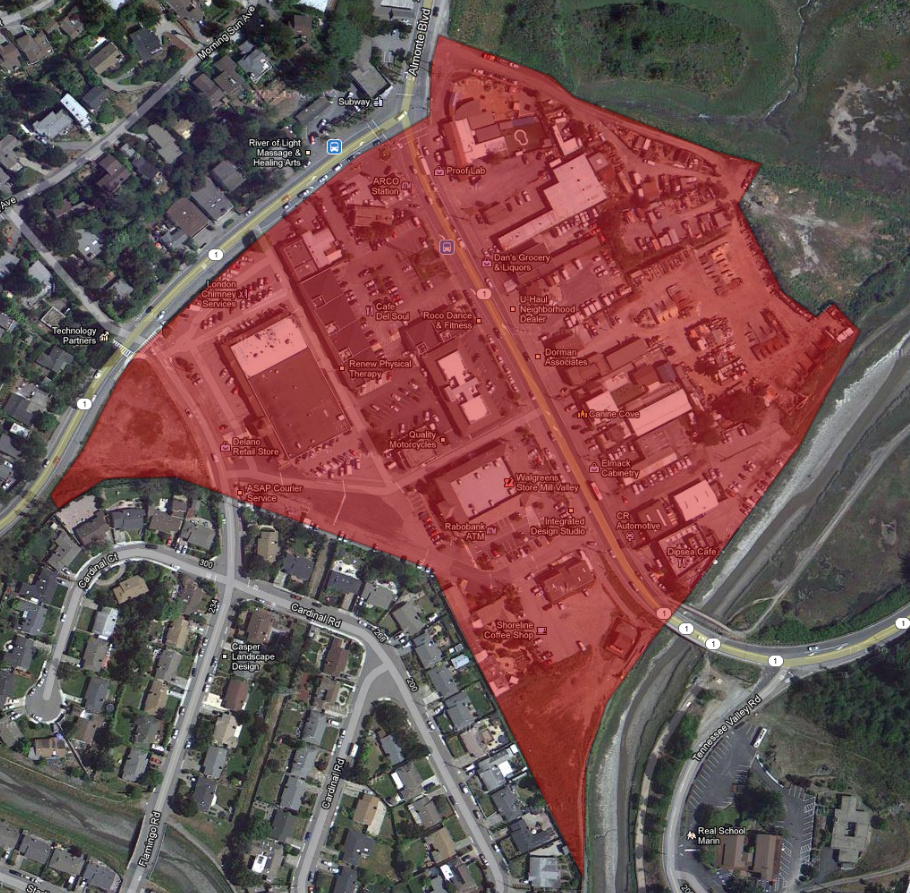There is a lot of heartburn around Tam Junction. Development, they say, is coming, development that will be ruinous to the neighborhood and anyone who moves into new homes. What’s actually going on? As it turns out, a whole lot less than imagined.
Background
Tam Junction is a 20-acre commercial strip wedged between Tam Valley and Almonte. It used to be the junction of the Interurban’s Mill Valley Line and their main lines to Central Marin, hence the name. Now, it’s the intersection of Highway 1 (aka Shoreline Highway) and Almonte Boulevard, and getting through there is suitably difficult.
Though I haven’t been able to corroborate the grade, Sustainable TamAlmonte says the intersection has a Level of Service grade of F, meaning it’s over-capacity. There’s a push in Caltrans and among neighbors to make the whole area more pedestrian and bicycle-friendly, which should take some pressure off the roads, but overall it is just a difficult intersection to traverse.
Tam Junction itself is built on flat, muddy soil, the kind that’s prone to liquefaction during an earthquake. Safe building standards, then, requires some serious reinforcement to bedrock. It’s a dusty, ugly, and semi-industrial bit of the county surrounded by some absolutely stunning scenery and some fairly charming homes.
The zoning for the strip is commercial, but it allows an FAR of 0.4, at most, and has a height limit of 30 feet. This means that it can only have 40 percent the square footage as the size of the lot – a 1000-square-foot lot could have only a 400-square-foot building, which itself can only be 30 feet tall. The northeast bit is part of the Baylands Corridor, a special protected area in the county’s General Plan that can’t be easily built upon.
What’s going on?
Tam Junction has been marked as a Project/Priority Development Area, also known as a PDA. This designation allows it to get additional funds for transportation infrastructure improvements, which it definitely needs. One Bay Area established the PDAs to help focus funding to areas that counties or cities deemed to be particularly worthwhile investments.
A common understanding is that a PDA designation is actually to focus housing development, but that’s not always the case. In essence, the purpose of a PDA is to align the transportation infrastructure with housing. That means either investing in housing development if the infrastructure is underutilized, or investing in infrastructure if what’s already there is over-capacity. Tam Junction falls mostly into the latter category.
I say “mostly” because the Marin’s state-mandated housing element points out six sites in Tam Junction that could be used for affordable housing development. These sites will in all likelihood never be developed: the high cost of construction in Tam Junction’s mud, not to mention the incredibly constrained building envelope, would scare away for-profit and non-profit developers alike. They’d be much more likely to invest in Sausalito, Miller Avenue, or San Rafael than in Tam Junction. The six sites point out the possibility of rezoning those areas to moderate densities but do not guarantee any development.
It’s important to point out that any development that would occur would not be out of character for area – 268-274 Shoreline Drive is a small strip of 30 unit-per-acre density, and Tam Junction already plays host to 30-foot-tall buildings.
Oppositional dissonance
In one sense, it’s a bit of a shame nothing would be built in the area. Sustainable TamAlmonte, a local group, strenuously opposes any residential development in the area while supporting any commercial development. Yet residents now can’t support more retail than is already there. If they could, someone would have taken over the psychic’s shop and opened something with a bit more pizzazz. The strip would need more residents to become a viable retail center. It can’t just become downtown Mill Valley because residents want it to be; it needs actual shoppers with actual money, and housing development would provide a way to do that without generating much traffic, as most new shoppers would be able to walk to their store of choice.
The other option would be to attract more shoppers from elsewhere in Marin, poaching some business from Sausalito and Mill Valley. Yet this option would attract even more traffic to the congested area, rendering it even more dangerous for residents walking, biking, driving, or simply living in the area. I hope Sustainable TamAlmonte isn’t suggesting this sort of development.
In sum, Tam Junction isn’t likely to change much more over the next decade than it has in the last decade. The barriers to development – namely mud and zoning – will make it difficult to do anything other than improve the existing infrastructure for existing residents and businesses. Given the harrowing testimonies of advocates at the last TAM meeting, that should be change enough.

